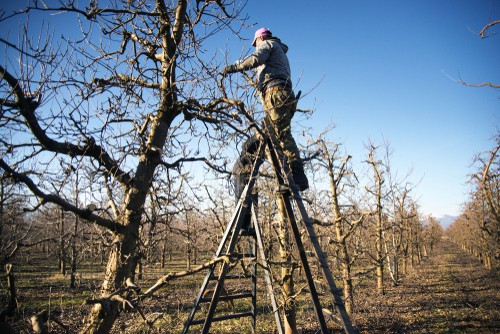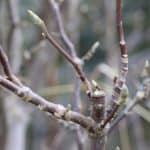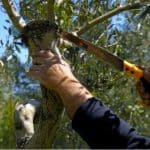Last updated on April 7th, 2022
Our site is reader supported, this means we may earn a small commission from Amazon and other affiliates when you buy through links on our site.
If you have a pear tree, do not be put off by the idea of pruning. Instead, take it a little at a time and you can enjoy a productive and well-shaped tree.
When should you prune your pear tree?
The best time to prune a pear tree is during the winter, but only after the leaves have fallen. This is better for the plant and better for you. Trying to assess the quality of your work is much harder when you stand back and only see an overgrown set of leaves and fruit.
How to prune your pear tree
When you are ready, make sure you have a safe ladder, for this, we highly recommend investing in a tripod ladder. You can get special fruit tripod ladders for this purpose, which is a sound investment if you plan to regularly prune your trees.
A sharp set of pruning secateurs or perhaps extendable loppers can make all the difference when you are precariously balanced on a ladder and trying to reach your arms out to undertake the final trim. If you can, sharpen your tools ahead of time, that will make the task of pruning much faster and easier.
Always make sure they are sanitised after sharpening too so that you do not accidentally transfer something from another plant to your tree.
The goal of pruning is to cut out some of the old wood each winter, so that new wood (and new pears) are produced the following spring. The majority of your fruiting wood is between 1 and 4 years old, and that is how you want to keep the tree branches to get the best fruit.
You also want to create an open centre in your tree for better air and light under the canopy to help ripen the fruit. With better airflow you can prevent diseases too.

How much should you remove?
When you are pruning away, your goal should be to remove between 10% and 20%. If you work your way around the tree in an even and methodical fashion, it will be easier to do this. If you think there is a lot more to cut off, make sure you stop at the 20% mark and come back to the tree the following year to get the rest because too much pruning at once will damage your tree.
That being said, the more you prune your pear tree with regularity, the stronger the new growth will be. So, if you prune well, it will grow back stronger. But if you prune too much, your tree will produce upright branches around the crown called water shoots. Should this happen, these need to be pruned at their origin.
Quick Tip!
If you have a very old tree, don’t get too excited and prune off the larger limbs. These bigger branches are at a higher risk of decay and if you want to remove it, follow the big branch back to a narrower section. Nothing more than 10-12cm should be removed at a time.
Additionally, your goal is to stagger the cuts throughout the canopy. If you only take away the top branches like a haircut, your tree will produce new growth up from the thicket that you have to cut off each year. Be selective about what you shorten or remove around your tree and focus your efforts on those areas that appear to be a bit crowded.


